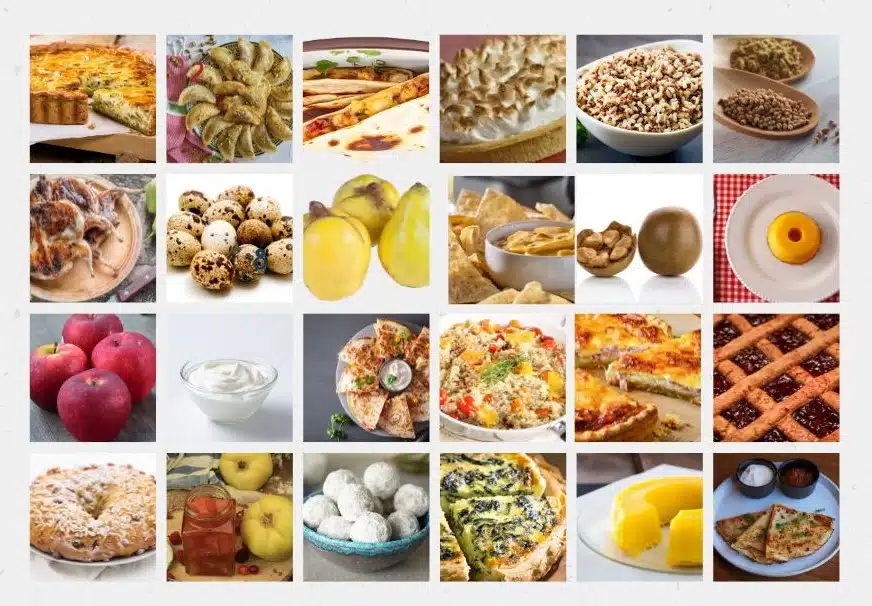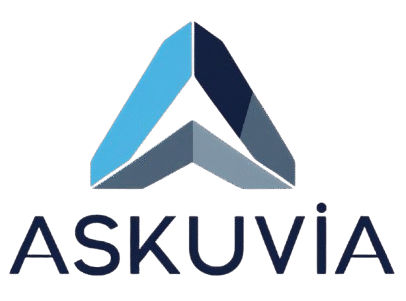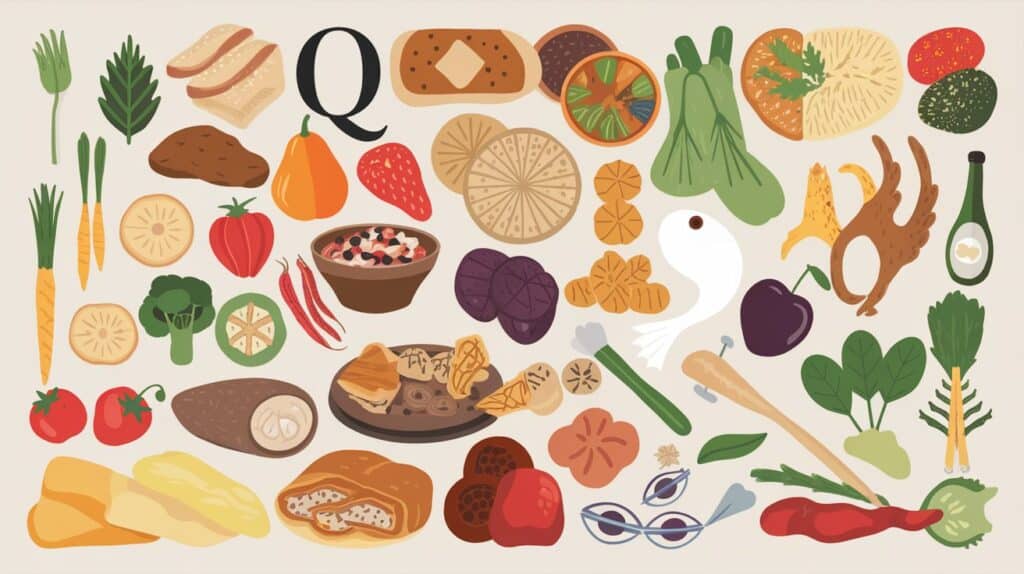Finding a food starting with AQ may seem impossible at first glance. In English culinary vocabulary, very few edible items begin with these letters. However, two remarkable entries Aquafaba and Aquavit qualify and hold immense cultural and functional importance. These two not only define culinary innovation but also represent two very different worlds: plant-based vegan cooking and Scandinavian tradition.
This article explores every angle of these rare “AQ” foods their origins, properties, nutrition, uses, and cultural context. It also expands to related items and questions to make this the most comprehensive guide ever written for the term “food starting with AQ.”

Understanding the Uniqueness of “AQ” Foods
Why Are Food Starting With AQ So Rare?
English food lexicons evolve from global cuisines, but few linguistic roots begin with the “AQ” combination. Most food-related words derived from Latin, French, or regional dialects start with vowels like A or E, or consonants like Q, but rarely AQ. Hence, Aquafaba (Latin aqua + faba) and Aquavit (Latin aqua vitae) are exceptions rooted in historical linguistic formations.
What Makes Them Special?
Both these foods showcase human innovation:
-
Aquafaba turned a waste product — chickpea water — into a plant-based miracle ingredient.
-
Aquavit preserved ancient distillation traditions, turning alcohol into a cultural emblem.
Let’s explore each in depth.
Aquafaba: The Miracle Ingredient from Beans
1. Definition and Etymology
Aquafaba is the starchy, protein-rich liquid left after cooking legumes (especially chickpeas).
The term combines two Latin words:
-
Aqua = water
-
Faba = bean
Discovered accidentally, Aquafaba became famous around 2014 when vegan chefs realized it mimics egg whites in baking and cooking.
2. Composition and Physical Properties
| Component | Percentage/Function | Role in Cooking |
|---|---|---|
| Water | 92–95% | Solvent for other molecules |
| Proteins | 1–2% | Foaming & binding |
| Starches & Carbohydrates | 2–3% | Thickening agent |
| Saponins | Trace | Emulsification & stability |
| Minerals (Sodium, Potassium) | Trace | Flavor balance |
The unique interaction between proteins and carbohydrates allows Aquafaba to trap air — forming stable foams similar to whipped egg whites.
3. Origin of Discovery
The discovery of Aquafaba’s culinary value was unplanned. In 2014, a French musician Joël Roessel noticed that chickpea liquid foamed like egg whites. Later, American software engineer Goose Wohlt used it successfully to make vegan meringue. Since then, Aquafaba became a global vegan kitchen essential.
4. How to Make Aquafaba
Step by Step Preparation:
-
Choose legumes – Chickpeas are preferred for consistent texture.
-
Soak overnight – Use 3 parts water to 1 part chickpeas.
-
Cook until soft – Simmer slowly to release starches and proteins.
-
Strain the liquid – Retain the water; this is raw Aquafaba.
-
Concentrate – Boil down gently if too thin.
-
Cool and store – Refrigerate up to 5 days or freeze for 3 months.
5. Culinary Applications
Aquafaba has revolutionized plant-based and allergen-free cooking.
a. Baking and Desserts
-
Vegan meringues, macarons, brownies, and marshmallows.
-
Light sponge cakes where egg foam structure is needed.
b. Savory Cooking
-
Vegan mayonnaise or aioli (as emulsifier).
-
Binding agent for burgers, fritters, and batters.
-
Thickener for soups and sauces.
c. Mixology
-
Used in cocktails (vegan whiskey sour, pisco sour) to create creamy foam without egg whites.
6. Substitution Ratios
| Egg Equivalent | Aquafaba Quantity |
|---|---|
| 1 Whole Egg | 3 tbsp (45 mL) |
| 1 Egg White | 2 tbsp (30 mL) |
| 1 Egg Yolk | 1 tbsp (15 mL) |
These ratios are industry-tested and used by professional bakers and chefs globally.
7. Nutritional Value
While Aquafaba has low calories and almost no fat, it’s valued more for its functional properties than nutrition.
| Nutrient | Per 100 mL |
|---|---|
| Calories | 3–5 kcal |
| Protein | 0.2–0.8 g |
| Carbohydrate | 0.5–1.0 g |
| Fat | 0 g |
| Sodium | 10–40 mg |
Source: Vegan Society Research on Aquafaba, 2023.
8. Benefits and Limitations
Benefits
-
100% vegan and allergen-free.
-
Eco-friendly (repurposes cooking water).
-
Works as a natural emulsifier and binder.
-
Zero cholesterol and low in calories.
Limitations
-
Variable consistency (depends on legume type).
-
Limited shelf life once opened.
-
Weaker structure than egg whites in some recipes.
9. Scientific Explanation
Aquafaba functions due to protein denaturation and starch gelatinization. During heating, soluble plant proteins unfold and trap air when whipped. Carbohydrates add viscosity, helping stabilize the foam. This dual mechanism mimics egg whites in aerated systems, proving invaluable for egg-free baking.
10. Popular Recipes Using Aquafaba
Sweet Uses:
-
Vegan Chocolate Mousse
-
Meringue Cookies
-
Aquafaba Buttercream
-
Lemon Macarons
-
Dairy-Free Ice Cream
Savory Uses:
-
Eggless Mayonnaise
-
Chickpea Omelette
-
Vegan Pancakes
-
Falafel Mix Binder
-
Aioli for Dips
11. Culinary Tips for Best Results
-
Use unsalted chickpeas to avoid altering taste.
-
Add acidic agents like lemon juice or cream of tartar to improve foam stability.
-
Avoid over-whipping — foam can collapse quickly once peaks form.
-
Test consistency: when liquid coats a spoon lightly, it’s ready.
12. Cultural and Environmental Impact
Aquafaba symbolizes sustainable cooking transforming waste into value. It aligns with zero-waste movements and supports vegan, gluten-free, and allergen-free lifestyles. Many sustainable chefs now list Aquafaba as a standard pantry item.
Aquavit: The Nordic Spirit with History
1. Definition
Aquavit, also known as Akvavit or Aqua Vitae, is a Scandinavian distilled spirit flavored mainly with caraway or dill. It literally means “water of life” in Latin.
2. Historical Background
Aquavit’s history traces back to the 15th century when distillation was considered medicinal. The earliest recorded bottle dates to 1531, found in Norway. Over time, it became central to Nordic celebrations such as Midsummer, Christmas feasts, and National Days.
3. Ingredients and Distillation
Primary Ingredients:
-
Neutral spirit (grain or potato base).
-
Botanicals like caraway, dill, fennel, anise, coriander, cumin, and orange peel.
Process Overview:
-
Base Fermentation: Grains or potatoes converted into ethanol.
-
Distillation: Alcohol purified via column or pot still.
-
Infusion: Botanicals steeped for flavor.
-
Maturation: (Optional) Some varieties aged in oak casks or sherry barrels.
-
Bottling: Typically 37.5–45% ABV.
4. Regional Variations
| Country | Base Ingredient | Color & Style | Key Brands |
|---|---|---|---|
| Norway | Potato | Aged, golden | Linie, Gammel Opland |
| Sweden | Grain | Clear or pale | O.P. Anderson, Skåne |
| Denmark | Grain | Clear, spicy | Aalborg Taffel, Jubilæums |
5. Flavor Profile
Aquavit has an earthy, spicy, and herbal character. Caraway provides the core aroma, supported by dill, fennel, and citrus. Aged versions develop notes of vanilla, oak, and sherry. The drink is often enjoyed chilled in small glasses with hearty Scandinavian dishes like pickled herring, gravlax, or meatballs.
6. Cultural Role
Aquavit is more than a beverage; it’s a cultural symbol. In Norway, each bottle of Linie Aquavit is matured by sailing across the equator twice — a marketing tradition called “the Linie journey.” In Sweden, it’s integral to traditional songs called snapsvisor, sung during festive meals.
7. Modern Use in Cocktails
Mixologists globally are reviving Aquavit. It’s used as:
-
Substitute for gin or vodka.
-
Base in cocktails like Nordic Negroni or Caraway Sour.
-
Pairing element for cured fish, cheeses, or charcuterie boards.
8. Nutritional Snapshot
| Component | Approximate Value (per 100 mL) |
|---|---|
| Calories | 230–250 kcal |
| Alcohol Content | 40–45% ABV |
| Sugar | 0 g |
| Carbohydrate | 0 g |
| Protein | 0 g |
Although alcoholic, Aquavit’s distinct botanical base contributes trace antioxidant compounds.
9. Responsible Consumption
Aquavit remains part of heritage cuisine. However, like all distilled spirits, it should be consumed in moderation. The World Health Organization defines moderate drinking as one standard drink per day for women and two for men (roughly 40 mL of Aquavit).
10. Key Facts About Aquavit
| Fact | Details |
|---|---|
| Origin | Scandinavia (Norway, Sweden, Denmark) |
| Main Botanicals | Caraway, Dill, Fennel |
| Alcohol by Volume | 37.5–45% |
| Serving Temperature | 6–8 °C (chilled) |
| Common Pairings | Pickled herring, cured meats, cheeses |
| Notable Tradition | Linie Aquavit crosses the equator twice |
Broader Context: Why “AQ” Foods Matter
The presence of “AQ” in food names reflects Latin heritage, where aqua (“water”) forms the root. This is evident in:
-
Aquafaba – Water from beans.
-
Aquavit – Water of life.
Such linguistic lineage shows how classical languages shaped food terminology, connecting culinary evolution to historical linguistics.
Other Foods Related to the ‘Q’ Category
While “AQ” foods are few, those starting with “Q” provide broader context:
| Food Name | Category | Description |
|---|---|---|
| Quinoa | Seed/Grain | Gluten-free protein-rich pseudocereal |
| Quark | Dairy | Soft fresh cheese popular in Europe |
| Quince | Fruit | Aromatic yellow fruit used in jams |
| Quesadilla | Dish | Mexican tortilla filled with cheese |
| Quail | Meat | Small game bird, rich in flavor |
| Qatayef | Dessert | Middle Eastern stuffed pancake for Ramadan |
These entries expand culinary vocabulary for readers who may search related terms.
Aquafaba vs. Aquavit
| Parameter | Aquafaba | Aquavit |
|---|---|---|
| Category | Plant-based ingredient | Distilled spirit |
| Origin | Vegan innovation (2014) | Nordic tradition (1500s) |
| Function | Egg substitute | Alcoholic beverage |
| Main Ingredient | Chickpeas or beans | Grain or potato + herbs |
| Key Nutrient | Proteins, starches | Alcohol compounds |
| Cultural Relevance | Vegan, sustainable | Scandinavian heritage |
Both embody unique facets of food innovation — one modern, one ancient.
Health and Sustainability Aspects
-
Aquafaba supports sustainability by reusing cooking water that would otherwise be discarded.
-
Aquavit, when produced traditionally, uses local botanicals and supports cultural craftsmanship.
Both highlight responsible resource use and preservation of culinary heritage.
FAQs
1. What food starts with AQ?
Only two recognized foods start with “AQ” — Aquafaba and Aquavit. Aquafaba is the cooking liquid from legumes, while Aquavit is a Scandinavian distilled spirit.
2. What is Aquafaba used for in cooking?
Aquafaba acts as a vegan substitute for eggs in baking, sauces, and cocktails due to its ability to foam, bind, and emulsify.
3. Can you make Aquafaba at home?
Yes. Simmer chickpeas in water, then save the strained liquid. Reduce it slightly until viscous — that’s homemade Aquafaba.
4. What does Aquavit taste like?
Aquavit tastes herbal and spicy, with dominant notes of caraway and dill, and occasionally fennel or citrus.
5. Is Aquafaba healthy?
Aquafaba is low in calories and cholesterol-free. It’s not nutrient-dense but offers functional benefits for plant-based diets.
6. How should Aquavit be served?
Traditionally, it’s served chilled in shot glasses, often paired with pickled fish or cheese during festive meals.
7. Can Aquafaba replace eggs in all recipes?
Aquafaba replaces eggs in many recipes but may not replicate structure in dense cakes or custards.
8. Why is Aquafaba called a vegan miracle?
Because it replicates egg-white properties, enabling vegans to enjoy meringues, mousses, and cocktails without animal products.
9. What is the alcohol percentage of Aquavit?
Aquavit contains between 37.5% and 45% alcohol by volume (ABV) depending on the brand.
10. Are there other “AQ” foods in any language?
Few regional dishes contain the prefix “Aqua” (like acqua pazza in Italian), but they don’t technically begin with “AQ” in English spelling.
Learn More: How to Bake Lasagna: Time, Temperature, and Technique
What Time Does Burger King Serve Lunch?
Conclusion
The culinary world contains thousands of ingredients, yet very few begin with the letters AQ. Among them, Aquafaba and Aquavit stand apart one representing modern vegan innovation, the other ancient Scandinavian craftsmanship.
Together, they prove that even rare alphabetical combinations can yield rich culinary narratives. From the sustainable kitchen to the festive table, foods starting with AQ embody creativity, history, and science — reminding us that discovery often begins where rarity exists.

